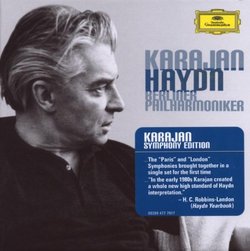| All Artists: Haydn, Karajan, Bpo Title: 6 Paris Symphonies/12 London Symphonies (Box) Members Wishing: 0 Total Copies: 0 Label: Dg Imports Release Date: 11/18/2008 Album Type: Box set, Import Genre: Classical Style: Symphonies Number of Discs: 7 SwapaCD Credits: 7 UPC: 028947779179 |
Search - Haydn, Karajan, Bpo :: 6 Paris Symphonies/12 London Symphonies (Box)
CD Details |
CD ReviewsThe Great Mr Haydn and the Great Mr Karajan Tom Henshaw | Macclesfield, Cheshire | 10/25/2009 (5 out of 5 stars) "The "Paris" and "London" Symphonies brought together in a single set for the first time: so states the wording on the sticker affixed to the front of this KARAJAN SYMPHONY EDITION box-set. The many enthusiastic reviews of other Karajan recordings posted on this site show, clearly, that the Maestro's popularity continues (happily) to endure. In light of this fact it strikes me as odd that no one has yet posted a review of the contents of this little box; therefore I would like to share my impressions of these recordings and at the same time, pay tribute to two very great gentlemen - Joseph Haydn and Herbert von Karajan. The symphonies of Haydn and the recordings of Herbert von Karajan are a new discovery for me, arrived at by an unusual route - a love of baroque music. After collecting, listening to - and ultimately rejecting - many examples of period instrument performance, I built a good CD collection of older recordings of baroque music, modern instrument performances, done in the traditional manner. One such disc (acquired a few months ago) made a great impression on me: a 1974 EMI recording of trumpet concertos of the baroque and early classical periods, featuring the Berlin Philharmonic, soloist Maurice Andre and directed, of course, by Karajan. I took a chance on this disc (fearing the interpretations might be a bit TOO rich), I needn't have worried - it is superb. Vaguely familiar with some of Haydn's music, and wanting to become better acquainted, I obtained another EMI disc, this one containing Karajan's '70s recordings of Haydn's Symphonies Nos. 83,101, and 104 - marvellous recordings - and a glorious introduction to these symphonies, now I wanted more. Imagine then, my delight, to learn that - for Deutsche Grammophon - Karajan had recorded all six "Paris" and all Twelve "London" Symphonies and that these were available as a box-set.
The handful of Haydn symphonies recorded by Karajan for EMI in the '70s were good, the recordings in this DG set - from the early 80s - are even better. Yes: this is big-band Haydn but - for Haydn - how big should a big-band be? We know that the "Paris" Symphonies were commissioned by Le Concert de la Loge Olympique (a masonic concert organisation in Paris). The orchestra put at Haydn's disposal for the premiere performances was considerably larger than the forces provided by his royal employers the Esterhazy family - including up to 70 strings, double wind, and timpani in Symphony No. 82, timpani and trumpets in no.86. Similar forces were employed for the "London" Symphonies; these were premiered at Hanover Square Rooms, the famous London concert hall which could seat up to 900 people. Now: if we follow this line - for one of our present day concert halls - Haydn would have expected a full-size modern symphony orchestra; of course, in the Berlin Philharmonic, this is exactly what he gets. I cannot help but be struck by how right the Berliners playing seems - every detail crisp, clear, clean. The flute answered by the oboe, then, by the bassoon in the 2nd movement of Symphony No. 96. The surprising, but delightful, appearance of the harpsichord in the final movement of No. 98. There is nothing ponderous or heavy about these interpretations. Karajan treats Haydn with dignity too, for example - the low bassoon note in the 3rd movement of Symphony No. 93 is often interpreted as a belch by others - not so with Karajan. Underpinning everything: great timpani work, blending perfectly with the ensemble, neither timid or bombastic, or - as with so many period instrument efforts - dry and flubby; I doff my cap to the Berliners timpanist. The tempos adopted by Karajan for the minuet movements have been described by some as slow; How slow is slow? The modern fashion is to rush these movements: that's all it boils down to - fashion. Take Symphony No. 83's 3rd movement; in Karajan's hands this goes with a mighty and majestic swing that would be completely obliterated if it were taken any faster. My discovery of these symphonies of Haydn and the recordings made of them by Herbert von Karajan and the Berlin Philharmonic orchestra has been a joy! Peruse - if you will - a book (or website) containing good reproductions of the paintings that Bernardo Bellotto (nephew of Canaletto) made of the capitals and cities of Europe in the late 18th Century: that's the world of Joseph Haydn. See the final photo in Richard Osbourne's excellent biography of Karajan; a posed, late, studio portrait. Karajan, baton poised, gazes past the viewer; it is a charismatic image. The caption reads: "It seems as though the music is coming from another world." and he said: "It is coming from another world - it is coming from eternity."" |

